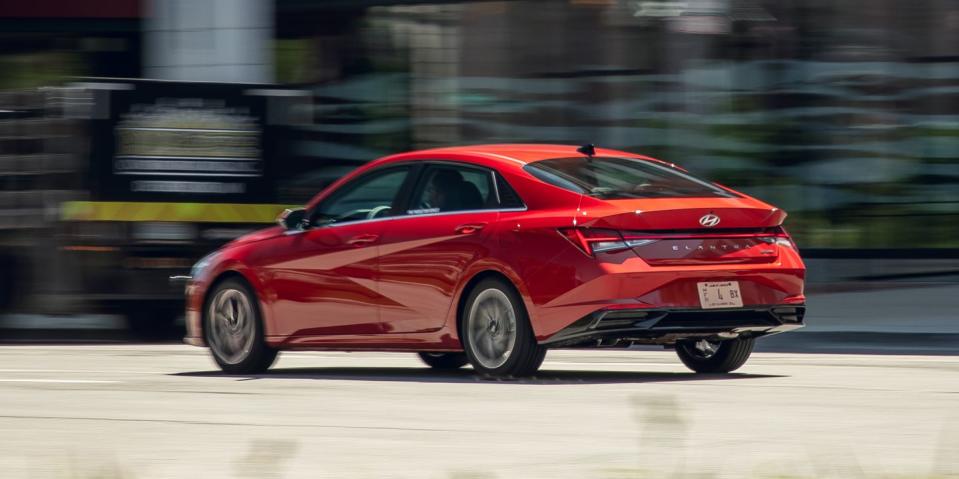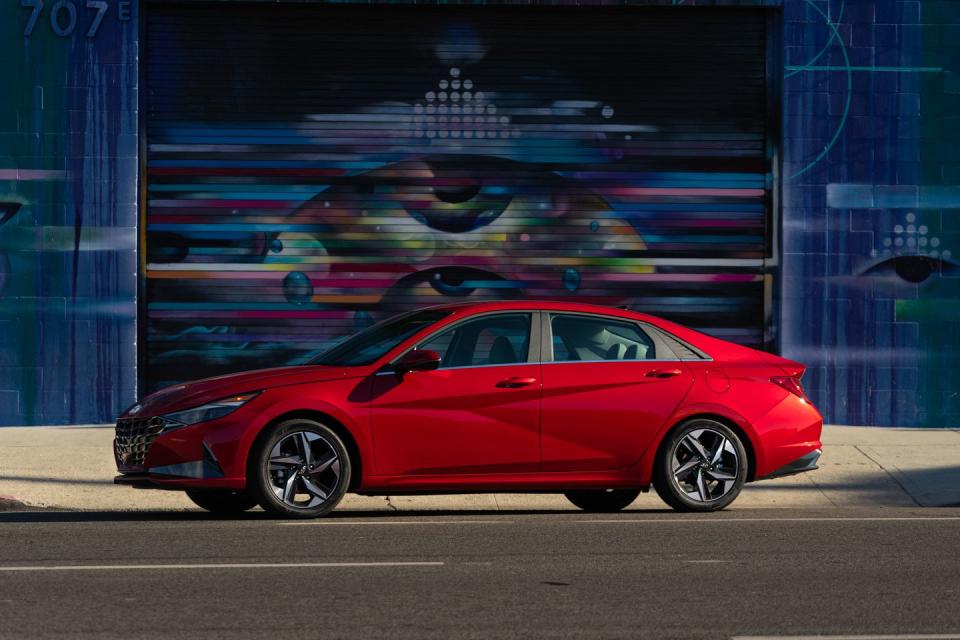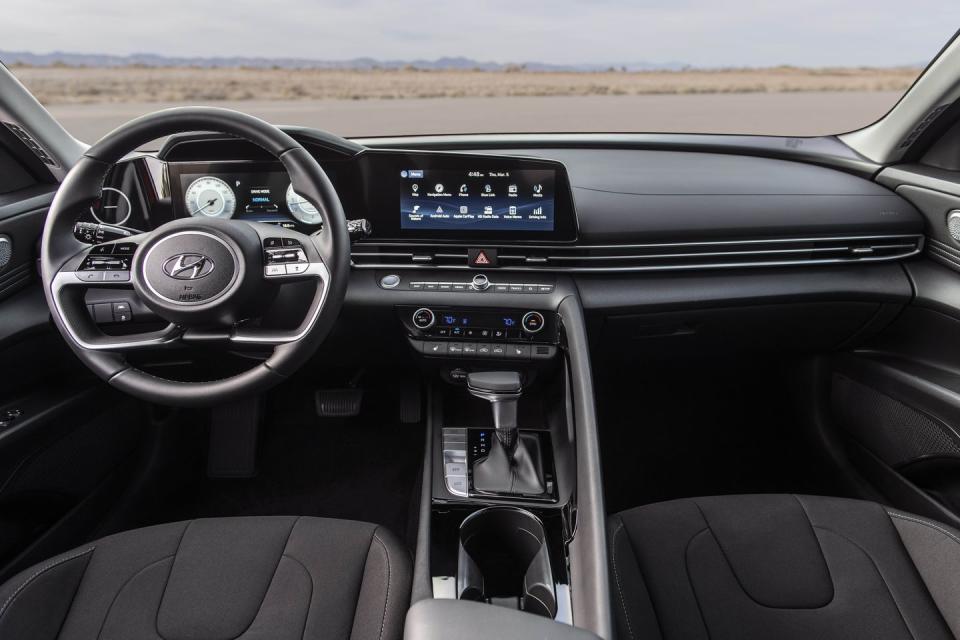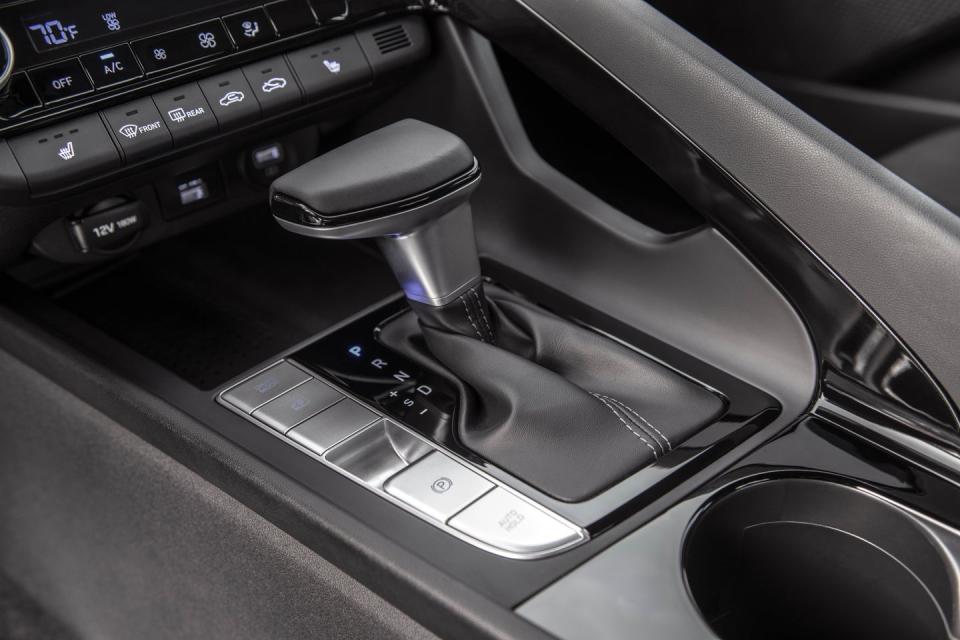2021 Hyundai Elantra Brings More Than Daring Design

Hyundai's North American senior designer Davis Lee walks us over to the new 2021 Hyundai Elantra and quickly addresses the car's boldly styled flanks. He reaches down and runs his hand along the three prominent creases that intersect on the sedan's front doors. "It can look out of place at first," he says, "but we wanted the car to stand out. And it adds character to the car."
Those character lines are a risky element of the Elantra's redesign, one that isn't shared with the larger Sonata or the 2022 Tucson. "We want to avoid a Russian-doll lineup," he adds. "Our design philosophy is that each vehicle must stand on its own visually. Notice how it's way more angular and edgy in back than the Sonata."
The redesign may turn off some traditional buyers, but the risks are small. The Elantra's 10-percent share of the compact sedan market is far less than the Honda Civic's and the Toyota Corolla's, both of which together command more than half of the segment's sales. To gain market share, especially among younger buyers, Hyundai had to go big. And it has, both visually and literally.

The seventh-generation Elantra is physically larger than it ever has been. At 184.1 inches, the Elantra stretches 2.2 inches longer than before and is nearly two inches longer than the best-selling Civic. It's also an inch wider and 0.8 inch lower than its predecessor, matching the dimensions of the Honda. More important, Hyundai stretched the wheelbase by 0.8 inch to 107.1 inches, giving the Elantra both the longest wheelbase in its class and a substantial amount of rear legroom. Rear headroom remains the same despite the sedan's lower overall height and swoopier roofline, but it's still tight for those taller than six feet. The Elantra's 14 cubic feet of trunk space is also about the same as before, splitting the difference between its two main rivals. A 60/40-split folding rear seat is standard.
Built on the third-generation of Hyundai's K platform, the Elantra features struts in front and a torsion-beam rear axle. Only the hybrid, N Line, and full-strength N models get an independent rear suspension, but you won't miss that more sophisticated setup on the standard car. The Elantra's handling dynamics have been tuned by people who actually like to drive. Body control in corners is excellent, and there's surprisingly good feel from the well-balanced steering.

On twisty two-lane roads, the Elantra impresses with ample front-end bite, and its rear end isn't easily upset by midcorner bumps. We drove a top-of-line Limited model with chunky 17-inch wheels wrapped in 225/45R-17 Kumho Majesty Solus all-season tires, which proved to be quiet to our ear while offering plenty of grip. The Elantra's ride quality is pleasantly firm, and there's a nice heft to its steering. It's relaxed around town yet still direct enough to be engaging. The view out front is expansive, thanks to a low dash and thin, carefully formed A-pillars.
Under the Elantra's hood, Hyundai's naturally aspirated 2.0-liter inline-four is paired with a standard continuously variable automatic transmission (CVT) that responds well to manual inputs for its simulated gear ratios. Though the combo is a bit sluggish off the line, the engine is generally responsive and makes good power above 4000 rpm, which is conveniently positioned at 12 o'clock on the tachometer. The engine's 132 pound-feet of torque peaks at 4500 rpm, and its 147 horsepower crescendos at 6200 rpm. Just as important, the SEL and Limited's EPA estimates of 31 mpg city, 41 mpg highway, and 35 mpg combined are competitive in its class. The base SE sees a 2-mpg bump in all three economy metrics.

Inside, the Elantra takes some additional design risks, such as the unnecessarily large grab handle on the passenger side of the center console. And the abstract circular design in the black void left of the steering wheel looks a bit weird. But the new cabin is otherwise spacious, attractive, comfortable, and nicely equipped. Even the base SE model, which starts at $20,645, gets an 8.0-inch touchscreen and the first application in the class of wireless Android Auto and Apple CarPlay. Automatic front- and rear-collision avoidance assistants with pedestrian detection are standard, as are lane-keeping and blind-spot collision avoidance assists.
That commendable amount of standard gear makes the SE a solid value. But the sweet spot in the lineup is the $21,895 SEL model with the optional $950 Convenience package, which nets 16-inch wheels, pushbutton start, a proximity key, a digital gauge cluster, a wireless phone charging pad, and other upgrades. Splurge for the $26,445 Limited trim and you'll gain a 10.3-inch touchscreen and customizable ambient interior lighting.
With the 2021 Elantra's new eye-catching wrapper, impressive feature count, and solid dynamics, Hyundai has smartly followed the playbook used by Honda when it introduced the current Civic—the most successful Civic generation on record and consistently Honda's best-selling car. Whether that formula works as well for the Elantra has yet to be seen, but it does make Hyundai's compact sedan more compelling than ever.
You Might Also Like

 Yahoo Autos
Yahoo Autos 